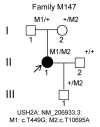Novel compound heterozygous nonsense variants, p.L150* and p.Y3565*, of the USH2A gene in a Chinese pedigree are associated with Usher syndrome type IIA
- PMID: 32945453
- PMCID: PMC7453661
- DOI: 10.3892/mmr.2020.11400
Novel compound heterozygous nonsense variants, p.L150* and p.Y3565*, of the USH2A gene in a Chinese pedigree are associated with Usher syndrome type IIA
Abstract
Usher syndrome refers to a group of genetically and clinically heterogeneous autosomal recessive diseases with retinitis pigmentosa (RP) and hearing deficiencies. The association between Usher syndrome‑causative genes and resultant Usher syndrome phenotypes in patients are highly variable. In the present study, a Chinese family with Usher syndrome was recruited, and targeted next‑generation sequencing, Sanger sequencing and segregation analysis were performed. The expression profiles and functional effects of the pathogenic variants of USH2A identified were analyzed. Novel nonsense compound heterozygous variants, c.T449G (p.L150*) and c.T10695A (p.Y3565*), were identified in the USH2A gene, which showed co‑segregation with the disease phenotype causing Usher syndrome type IIA in the recruited Chinese pedigree. The p.L150* variant was predicted to produce a truncated protein which lacked almost all the functional domains of USH2A, whereas the p.Y3565* variant is located in one of the fibronectin type 3 domains, resulting in the loss of several fibronectin type 3 domains at the C‑terminus of USH2A by producing the truncated protein. It was shown that Ush2a mRNA expression levels were higher in the retina compared with those in the eye tissues (lens, sclera and cornea), uterus, ovary, breast, testis, spleen, kidney, liver, intestine, brain, skeletal muscle and blood. Additionally, the protein structure was shown to be highly conserved by comparing Homo sapiens USH2A to eight other species. To the best of our knowledge, the present study is the first to identify two novel pathogenic variants, c.T449G (p.L150*) and c.T10695A (p.Y3565*), in the USH2A gene in a patient with Usher syndrome type IIA, thereby expanding the known spectrums of USH2A causative mutations. The present discovery may assist in understanding the molecular pathogenesis underlying the development of RP and Usher syndrome type IIA, and in the development of diagnostic, therapeutic and genetic counseling strategies in patients with Usher syndrome type IIA disease.
Figures





References
MeSH terms
Substances
Supplementary concepts
LinkOut - more resources
Full Text Sources
Medical

